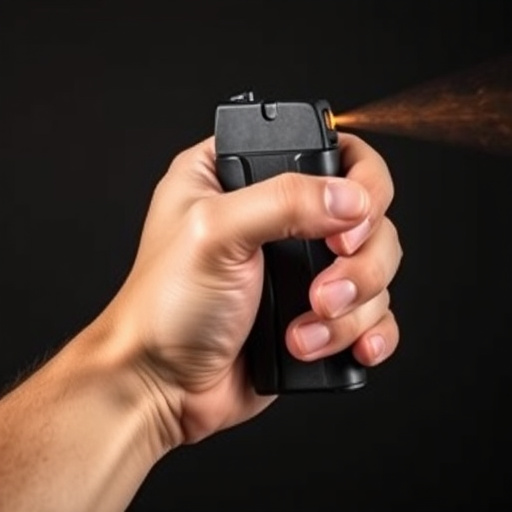In personal defense, non-lethal tools like pepper spray gel and stream offer distinct advantages. Pepper spray gel’s adhesive composition enables targeted application for immediate discomfort, while stream sprays provide precise, controlled delivery from a safe distance. Gel is superior in close quarters due to its lack of aiming requirement, but stream has a shorter range with easier targeting of sensitive areas. The choice between them depends on individual needs, environmental factors, and desired control during defensive situations, as highlighted in the comparison of Pepper Spray Gel Vs Stream.
In today’s world, personal safety is paramount. Non-lethal inflammatory self-defense tools offer a crucial alternative to conventional weapons, especially in situations where de-escalation is key. This comprehensive guide delves into two prominent options: pepper spray gel and stream spray. We explore their unique compositions, effects, and benefits, providing insights that help users make an informed choice between these popular self-defense mechanisms, particularly when comparing pepper spray gel vs. stream.
- Understanding Non-Lethal Inflammatory Self-Defense Tools
- Pepper Spray Gel: A Closer Look at Its Composition and Effectiveness
- Stream Spray: Features, Benefits, and Considerations
- Comparing Pepper Spray Gel vs Stream: Which Is the Better Option for Self-Defense?
Understanding Non-Lethal Inflammatory Self-Defense Tools
In the realm of personal defense, non-lethal tools have gained significant attention as a safer alternative to firearms. Among these, inflammatory self-defense options like pepper spray and gel stand out for their ability to incapacitate assailants temporarily without causing permanent harm. The key difference lies in the delivery method: pepper spray uses a mist or stream of capsaicin solution, while gel formulations offer direct contact irritants.
When comparing pepper spray gel vs. stream, users often consider factors such as range, effectiveness, and ease of application. Pepper spray streams provide a longer effective reach, making them suitable for maintaining distance from potential threats. Conversely, gel forms offer more controlled and targeted application, ensuring direct contact with the aggressor’s eyes and skin. Understanding these distinctions is vital in choosing the right tool based on individual needs and environmental considerations.
Pepper Spray Gel: A Closer Look at Its Composition and Effectiveness
Pepper spray gel, a non-lethal self-defense tool, has gained popularity for its unique composition and effectiveness in neutralizing attackers. Unlike traditional pepper spray that comes in liquid form, this gel is designed to adhere to an aggressor’s skin, eyes, and clothing, causing a burning sensation and temporary blindness. Its viscous texture allows for more control during application, making it easier to target specific areas without accidental exposure to the user.
When compared to stream pepper spray, gel forms offer several advantages. Stream sprays rely on a direct spray pattern, which can be challenging to aim accurately in close-quarters situations. In contrast, pepper spray gel’s adhesive nature ensures contact with the attacker, delivering an immediate and powerful sting. This property makes it particularly effective in close combat scenarios where speed and precision are crucial for self-defense.
Stream Spray: Features, Benefits, and Considerations
Stream spray represents a significant advancement in non-lethal self-defense tools, offering a unique blend of features and benefits compared to its traditional counterpart, pepper spray gel. One of its key advantages is the precise and controlled delivery mechanism. Unlike pepper spray gel, which often relies on direct contact or proximity to affect the target, stream spray projects a narrow, powerful jet of irritant, allowing users to neutralize an aggressor from a safe distance.
This feature is particularly useful in situations where the user wants to disable an attacker without escalating the violence or causing unnecessary harm. The stream’s precision enables the applicator to aim for sensitive areas such as eyes and face, providing a swift and effective response. Additionally, stream spray can be easier to handle due to its ergonomic design, making it a more accessible option for individuals seeking a reliable self-defense mechanism.
Comparing Pepper Spray Gel vs Stream: Which Is the Better Option for Self-Defense?
When it comes to non-lethal inflammatory self-defense tools, Pepper Spray Gel and Stream offer distinct advantages and considerations. Pepper spray gel is a viscous substance that clings to an attacker’s skin and eyes, causing irritation and disorientation. It provides a longer range than stream options and can be more effective in crowded areas where direct contact may be difficult. However, its stickiness might lead to accidental activation or difficulty applying in fast-paced situations.
On the other hand, pepper spray streams offer a direct and powerful hit, making them ideal for close-quarters defense. They are easier to control and aim, allowing users to target specific areas with precision. While stream options have a shorter range, they can be more effective in open spaces or when an attacker is wearing protective gear. The choice between gel and stream depends on individual preferences, the expected environment during use, and the level of control desired by the user.
In exploring non-lethal inflammatory self-defense tools, both pepper spray gel and stream spray offer unique advantages. While pepper spray gel is known for its high concentration of capsaicin, providing a potent but localized reaction, stream spray disperses a fine mist, allowing for wider coverage and a slightly milder sting. When deciding between the two, considering factors like range, duration of effect, ease of use, and personal preference becomes crucial. Ultimately, both options can empower individuals with effective self-defense tools, ensuring safety in various situations, making the choice between pepper spray gel vs stream a matter of tailored protection.
